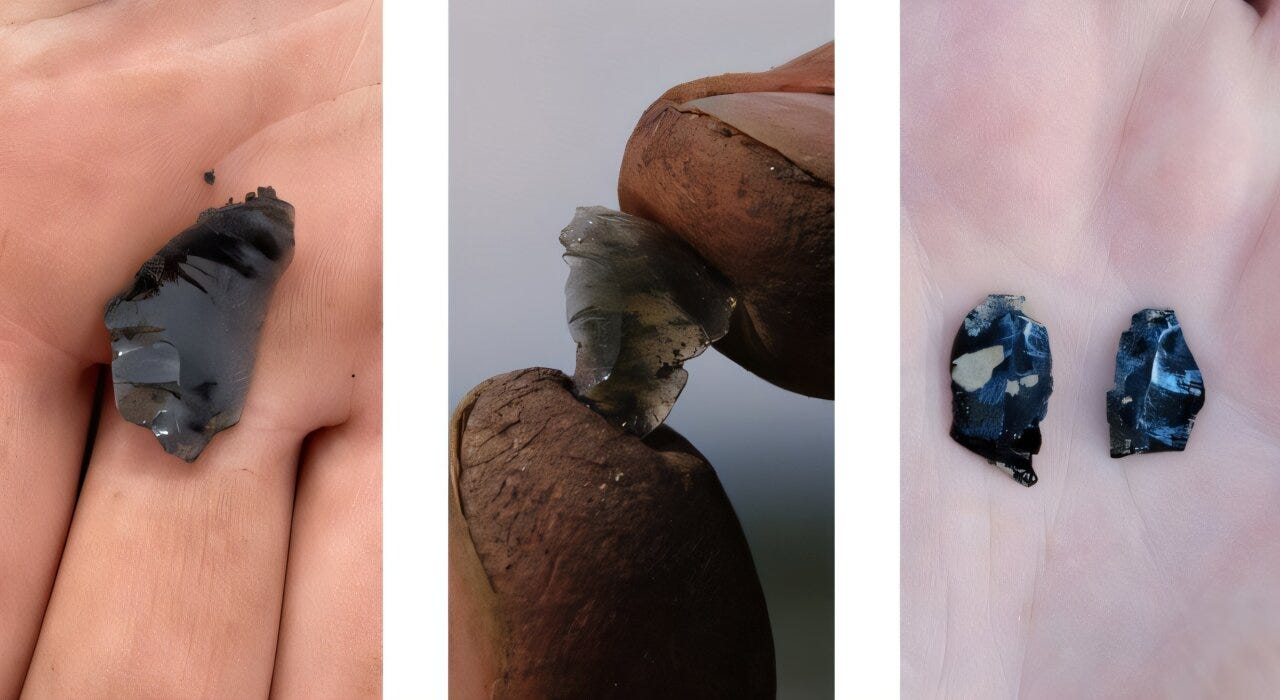Obsidian, a naturally occurring volcanic glass, has long captivated archaeologists due to its sharpness and distinctive properties. Despite Alberta's lack of volcanic activity, numerous obsidian artifacts have been unearthed across the province, prompting questions about their origins and the prehistoric networks that transported them. Recent studies1 shed light on these ancient trade routes, revealing a complex web of interactions among Indigenous communities.

The Enigma of Alberta's Obsidian
Over 500 archaeological sites in western Canada have yielded obsidian artifacts, including arrowheads and spear tips. Geologically, Alberta lacks natural sources of obsidian, suggesting these materials traveled vast distances. Tim Allan, an archaeologist with the Archaeological Survey of Alberta, emphasizes that finding obsidian at a site is a clear indicator of long-distance trade among prehistoric populations.
"Finding obsidian at an archaeological site is a bona fide indicator of long-distance trade among prehistoric populations," Allan notes.
Tracing the Origins
To determine the provenance of these artifacts, researchers employed X-ray fluorescence (XRF) technology, analyzing 383 obsidian pieces from 96 sites across Alberta. The results revealed that the majority originated from four primary sources: Bear Gulch in Idaho, Obsidian Cliff in Wyoming, and Anahim Peak and Mount Edziza in British Columbia. Some artifacts had traveled nearly 1,200 kilometers from their source. Allan suggests that a single piece of obsidian likely exchanged hands many times, highlighting the extensive trade networks of the time.
"A single piece of obsidian likely exchanged hands many times," he explains.
Obsidian at Bison Jumps
A significant number of obsidian artifacts were discovered at bison jump sites—locations where Indigenous hunters would drive bison off cliffs. This association suggests a connection between communal hunting practices and the distribution of obsidian. While the exact nature of this relationship remains under investigation, it underscores the social and economic complexities of these ancient communities.
River Networks and Trade Routes
The distribution patterns of obsidian artifacts indicate that river networks played a crucial role in prehistoric trade. Waterways likely served as conduits for the movement of goods and ideas, facilitating interactions among distant groups. Allan emphasizes the interconnectedness of Indigenous communities prior to European contact, noting that these trade networks spanned thousands of kilometers.
"Indigenous communities were extremely interconnected prior to European contact and colonization," Allan observes.
Conclusion
The presence of obsidian artifacts in Alberta offers a window into the intricate trade networks and social dynamics of prehistoric Indigenous populations. Through advanced sourcing techniques, researchers continue to piece together the routes and relationships that defined ancient North America. These findings not only illuminate the past but also highlight the enduring legacy of Indigenous trade and communication networks.
Related Research
Burchill, A. (2022). Findings and interpretations at GbQn-13, an Early Prehistoric Period site in Alberta’s west central Foothills. Archaeological Survey of Alberta occasional paper no. 41.
This study examines the GbQn-13 site, revealing insights into early prehistoric occupations and the presence of obsidian artifacts.Kristensen, T., & Fedyniak, K. (2015). Tracking Ancient Connections: The Alberta Obsidian Project. RETROactive.
This article discusses the Alberta Obsidian Project's efforts to trace the origins of obsidian artifacts and reconstruct ancient trade routes.Allan, T. E., & Leslie, B. (2020). GiPk-3: An obsidian tool find near Fawcett Lake, Alberta. Alberta Archaeological Review.
This paper reports on the discovery and analysis of an obsidian tool, providing context for its significance within Alberta's archaeological record.
Alberta Obsidian Project chronicles : obsidian research within Alberta’s Eastern Slopes. (n.d.). Alberta.Ca. Retrieved April 8, 2025, from https://open.alberta.ca/publications/occasional-paper-43-allan-eastern-slopes-obsidian










Share this post